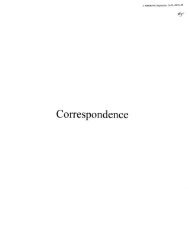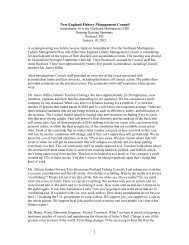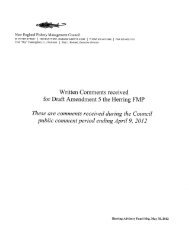Smooth Bottom Net Trawl Fishing Gear Effect on - New England ...
Smooth Bottom Net Trawl Fishing Gear Effect on - New England ...
Smooth Bottom Net Trawl Fishing Gear Effect on - New England ...
Create successful ePaper yourself
Turn your PDF publications into a flip-book with our unique Google optimized e-Paper software.
NOAA/NMFS Unallied Science Project, Cooperative Agreement NA16FL2264 December 2005<br />
<str<strong>on</strong>g>Smooth</str<strong>on</strong>g> <str<strong>on</strong>g>Bottom</str<strong>on</strong>g> <str<strong>on</strong>g>Net</str<strong>on</strong>g> <str<strong>on</strong>g>Trawl</str<strong>on</strong>g> <str<strong>on</strong>g>Fishing</str<strong>on</strong>g> <str<strong>on</strong>g>Gear</str<strong>on</strong>g> <str<strong>on</strong>g>Effect</str<strong>on</strong>g> <strong>on</strong> the Seabed:<br />
Investigati<strong>on</strong> of Temporal and Cumulative <str<strong>on</strong>g>Effect</str<strong>on</strong>g>s BKAM/CR<br />
3.4.4 Little Tow Post-<str<strong>on</strong>g>Trawl</str<strong>on</strong>g> Results (October 9 and November 19, 2002)<br />
Average densities in the first post-trawl samples taken in early October at trawled lane stati<strong>on</strong>s<br />
(LT1B and LT3A) were 875 individuals, and species richness was 62 organisms per grab. This<br />
was not significantly different from the pre-trawl results. Pri<strong>on</strong>ospio was dominant in both<br />
trawled lanes in the first post-trawl sampling. In the sec<strong>on</strong>d post-trawl sampling, in November,<br />
Pri<strong>on</strong>ospio remained dominant at LT1B, but at LT3A both Spio limicola and Anobothrus gracilis<br />
were more abundant than Pri<strong>on</strong>ospio. The remaining comp<strong>on</strong>ents of the fauna were quite<br />
similar before and after trawling.<br />
The c<strong>on</strong>trol lane stati<strong>on</strong>s (LT2B and LT4A) at Little Tow averaged 602 individuals of 54 species<br />
in October. Dipolydorus was no l<strong>on</strong>ger the most abundant species. The most comm<strong>on</strong> species<br />
was Nucula delphinod<strong>on</strong>ta followed by Anobothrus gracilis. There were <strong>on</strong>ly 19 individuals of<br />
Pri<strong>on</strong>ospio, which had been the dominant organism in the pre-trawl samples. There were<br />
significant numbers of a Foraminiferan (Sarcodina A) in both post-trawl sampling events. The<br />
most numerous species at LT2B in the November survey was Phor<strong>on</strong>is architecta. The<br />
amphipod Unciola inermis, comm<strong>on</strong> in pre-trawl samples (56 individuals), was represented by<br />
<strong>on</strong>ly two individuals in the post-trawl surveys. This was probably due to a slight change in grain<br />
size since Unciola prefers sandier sediments. At LT4A, Nucula delphinod<strong>on</strong>ta was numerically<br />
dominant in both post-trawl samplings. Pri<strong>on</strong>ospio was ranked am<strong>on</strong>g the middle of the other<br />
dominants, which included Spio limicola, Tharyx acutus, Owenia fusiformis, and Phor<strong>on</strong>is<br />
architecta, all of which were am<strong>on</strong>g the dominant species in pre-trawl samples.<br />
3.4.5 Community Analyses<br />
Faunal data was subjected to cluster analysis and ordinati<strong>on</strong> methods including principal<br />
comp<strong>on</strong>ents analysis using the software package BioDiversity Professi<strong>on</strong>al, Versi<strong>on</strong> 2. The data<br />
was subjected to a square root transformati<strong>on</strong> to reduce the influence of abundant species. No<br />
species were present in extremely high abundances (1,000’s per grab) and hence the more severe<br />
log transformati<strong>on</strong> was not deemed necessary. Comparis<strong>on</strong>s between square root and log<br />
transformati<strong>on</strong>s in test runs showed no significant differences in the way samples clustered. The<br />
Bray-Curtis similarity coefficient was calculated between sample pairs and the resultant data was<br />
subjected to group average clustering. Analyses were performed <strong>on</strong> combined replicate data<br />
(results from 3 replicates summed) and <strong>on</strong> individual replicates. A single replicate sample<br />
(LT2B-P1-3) was dropped from analyses because the sample was not preserved correctly and<br />
animals had disintegrated. For comparis<strong>on</strong>s between years 2001 and 2002, replicate data from<br />
the same sites in each year was averaged since there were varying numbers of replicates (1 to 3)<br />
collected in 2001. Dendograms illustrating differences based <strong>on</strong> sites, seas<strong>on</strong>s, and years (2001<br />
verses 2002) are shown in Figures 3.4-5 and 3.4-6. Clusters of individual replicates and the<br />
results of principal comp<strong>on</strong>ents analysis are shown in (Figures 3.4-7 through 3.4-14).<br />
Figure 3.4-5 shows the results of clustering the combined replicates from all of the 2002<br />
samples. The samples clearly separated by area, with the samples from Mud Hole grouping into<br />
the first two clusters and the samples from Little Tow grouping into the remaining clusters.<br />
Additi<strong>on</strong>ally, samples within each of the areas further separated. In Mud Hole further separati<strong>on</strong>s<br />
45







